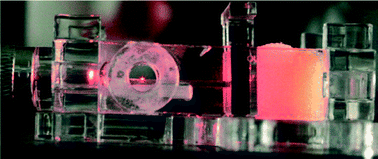Plug and measure – a chip-to-world interface for photonic lab-on-a-chip applications†
Abstract
The integration of detection mechanisms with microfluidics may be one of the most promising routes towards widespread application of Lab-on-a-Chip (LoC) devices. Photonic detection methods like in the so-called Photonic Lab-on-a-Chip (PhLoC) have advantages such as being non-invasive, easy to sterilize and highly sensitive even with short integration times and thus allow in situ monitoring and quantification of biological and chemical processes. The readout of such detection methods usually requires special training of potential users, as in most cases they are confronted with the need of establishing fiber-optics connections to and from the PhLoC and/or rely on the use of complex laboratory equipment. Here, we present a low-cost and robust chip-to-world interface (CWI), fabricated by CO2-laser machining, facilitating the non-expert use of PhLoCs. Fiber-optics with standard SMA-connectors (non-pigtailed) and PhLoCs can be plugged into the CWI without the need for further adjustments. This standardization bestows great versatility on the interface, providing a direct link between PhLoCs and a wide range of light sources and photo-detectors. The ease-of-use of the proposed simple plug mechanism represents a step forward in terms of user-friendliness and may lead PhLoC devices to practical applications.


 Please wait while we load your content...
Please wait while we load your content...